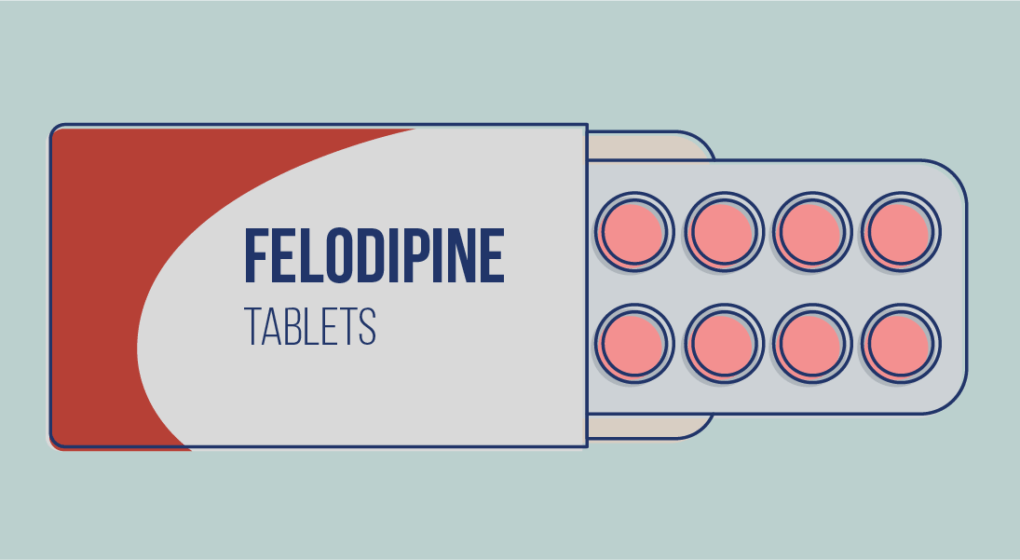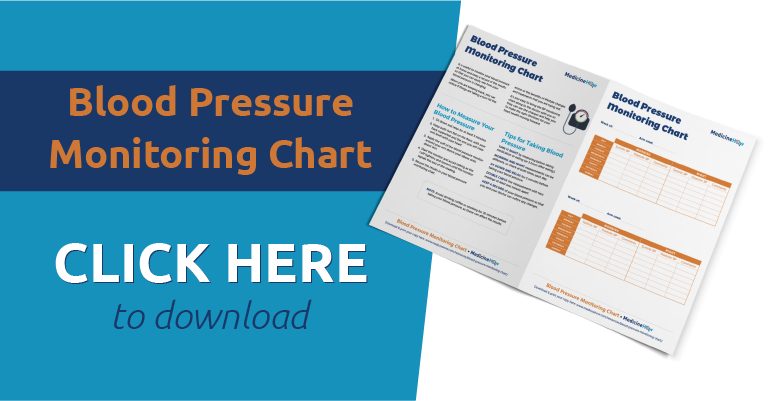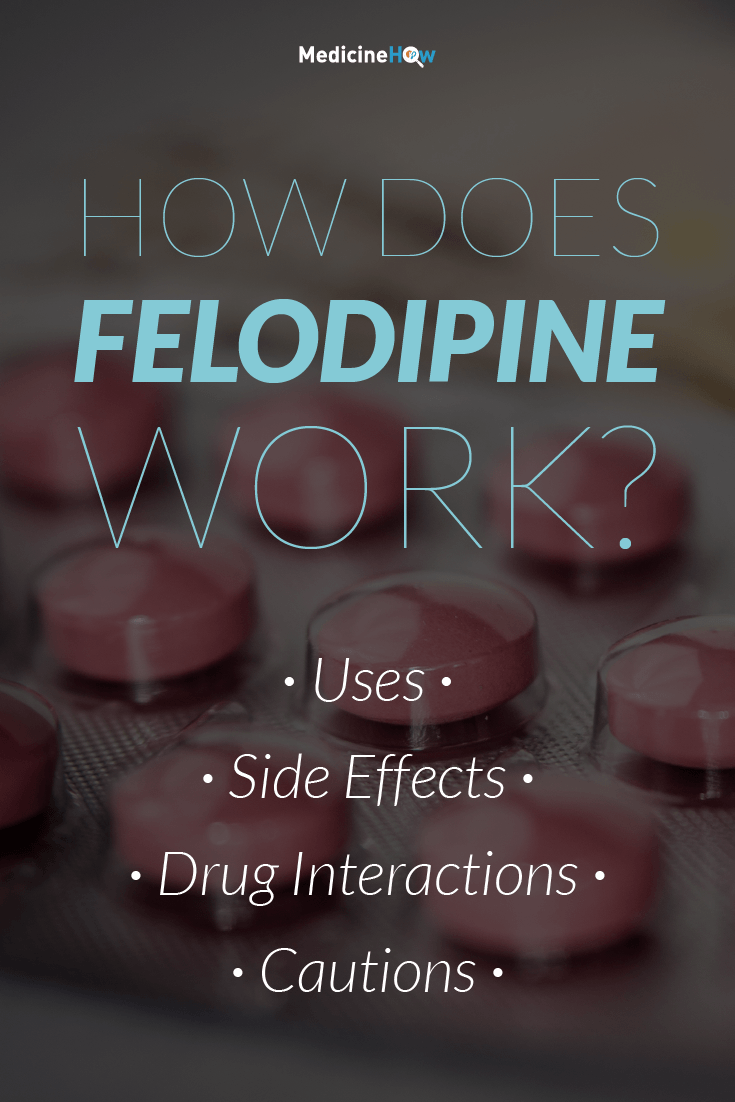
Felodipine is a type of drug called a calcium channel blocker, which works to reduce blood pressure by relaxing the muscles around the blood vessels. If you or someone you know is taking felodipine and you’d like to know more about how it works, this is for you.
Brand Names and Doses
![]() Felodipine is the generic name – the name of the actual drug component inside your medication. The brand name written on the packaging might be slightly different like:
Felodipine is the generic name – the name of the actual drug component inside your medication. The brand name written on the packaging might be slightly different like:
- Felodur ER
- Plendil ER
- Felodil XR
All of these medications contain the same drug and do exactly the same thing –their names are just different because different companies manufacture them.
Each brand comes in several different doses: 2.5, 5 and 10 mg. When starting felodipine medication for the first time, it is best to begin with a 5 mg tablet and to adjust the dose until it is working as it should be. This helps to make sure it is working, while decreasing the risk of any side effects as your body adjusts to the drug.
What does the ER and XR mean? It’s short for extended release. The reason for this is that your body is too good at getting the drug out of your body. If you take a 10 mg dose in the morning, only 5 mg will still be left in your body later that evening, only about 3 mg the next morning when it’s time to take your next dose. Rather than taking two doses a day, it is specially formulated (ER or XR) to release the drug slowly and evenly throughout the whole day. Because it is formulated is a specific way, it is important that you swallow the tablet whole rather than crushing it or chewing it, as it will affect the way it is released into your body.
Felodipine is also available in combination with ramipril in one tablet, known as Triasyn. This is available in several different doses, so that everyone can find the dose suited for them.

What type of drug is Felodipine?
![]() Felodipine is a type of drug called a dihydropyridine calcium channel blocker. This is a drug class that helps us to group drugs that work in a similar way together.
Felodipine is a type of drug called a dihydropyridine calcium channel blocker. This is a drug class that helps us to group drugs that work in a similar way together.
Other drugs in the same class are:
How does Felodipine work?
![]() Felodipine is used to manage hypertension because the way it works is very effective at reducing the blood pressure in the body.
Felodipine is used to manage hypertension because the way it works is very effective at reducing the blood pressure in the body.
Calcium channel blockers like felodipine block the passage of calcium into the cells. Calcium is important in the body and is needed to allow some muscles, like the smooth muscles in your heart and surrounding your blood vessels, to contract. When you take a dose of felodipine, these muscles can’t contract properly, which loosens around the vessels and decreases the blood pressure.
This allows the blood to flow through more easily, like putting your hand into a glove the right size, instead of trying to squeeze it into one that is a few sizes too small. As a result, there is less pressure on your heart to pump blood around your body and you are less likely to experience cardiovascular problems.
Felodipine is a special type of calcium channel blocker, called a dihydropyridine calcium channel blocker. This simply means that its effect is more pronounced on the blood vessels and less on the heart muscles.
Side Effects
![]() The most common side effects of felodipine happen because the drug is working too well – instead to high blood pressure, you end up with low blood pressure. Signs of hypotension are:
The most common side effects of felodipine happen because the drug is working too well – instead to high blood pressure, you end up with low blood pressure. Signs of hypotension are:
- Headache
- Tiredness
- Dizziness
- Flushing
If you notice these signs, your dose of felodipine may too high and you should discuss this with you doctor, who will help to find the right dose for you.
Felodipine can also sometimes cause retention of fluid in your body, making your ankles appear swollen. This is called oedema and also usually means the amlodipine dose is too high – if you notice this, see your doctor as soon as possible to talk about the effects and what you can do.
Cautions
![]() Felodipine is supposed to be taken long-term to help you to control your blood pressure. If you stop taking it suddenly, the smooth muscles around your blood vessels will suddenly be able to contract again and will tighten to cause hypertension to come back even worse.
Felodipine is supposed to be taken long-term to help you to control your blood pressure. If you stop taking it suddenly, the smooth muscles around your blood vessels will suddenly be able to contract again and will tighten to cause hypertension to come back even worse.
Instead, you should gradually reduce the dose over time to allow your body time to readjust. For example, if you are currently taking 10mg, your doctor might reduce your dose to 5 mg and then you can take half a 5 mg tablet (2.5 mg) for some time before stopping completely.
You might also find that felodipine affects your mental coordination, making you feel more tired than usual and lack alertness. If this happens to you, you should avoid driving or operating heavy machinery, as the consequences if you lose concentration could be disastrous.
Some normal foods can also interact with felodipine in your body and change the effect it has. A good example of this is grapefruit juice. If you like grapefruit, you don’t need to avoid it completely, but should be aware it can change the way the drug works and keep an eye out for side effects. A glass each day is likely to be okay, but suddenly drinking a liter in one day might be asking for trouble.

Interactions
![]() Felodipine is known to interact with several different drugs in your body. Sometimes it is best not to take specific drugs together but in some cases your doctor can simply change the dose of the medications to allow for the interaction.
Felodipine is known to interact with several different drugs in your body. Sometimes it is best not to take specific drugs together but in some cases your doctor can simply change the dose of the medications to allow for the interaction.
- Erythromycin can stop your body from breaking felodipine down in the liver as normal, leading to an increased level in your body and greater risk of side effects. If this happens, talk to your doctor about decreasing the dose of your felodipine medication.
- Itraconazole also stops your body from breaking felodipine down in the liver as normal. Additionally, both drugs increase risk of heart failure due to an inotropic effect. It’s best to avoid this combination, but is some cases it is used with a lower felodipine dose than normal.
- Tacrolimus is not broken down as well in your body when taken with felodipine, which can lead to more side effects. You can take both together, however, as long as the dose of tacrolimus is reduced.
Pregnancy and Breastfeeding
![]() If you are pregnant, breastfeeding or planning to become pregnant in the future, taking felodipine is not recommended. Why?
If you are pregnant, breastfeeding or planning to become pregnant in the future, taking felodipine is not recommended. Why?
As it may cause maternal hypotension, it can lead to poor oxygen supply to your baby due to the blood flow you provide. The drug is excreted in breast milk and is likely to affect your baby and is, therefore, not usually used. There is no research to say whether or not it is safe or your baby.


